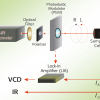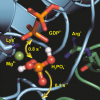Articles and Columns
Our focus here is analytical procedures and the role of nuclear magnetic resonance (NMR) in particular. These have, until now, largely relied on conventional chromatography, and vibrational spectroscopy—infrared (IR), Raman and near infrared (NIR) spectroscopy. In spite of inherent difficulties with peak assignment and reliable quantification, vibrational spectroscopy has been used to derive information on reaction progression to impart fundamental understanding. This article sets out a wider scope to show how NMR can play a key role. Furthermore, NMR integrates well with established procedures to provide a suite of useful technologies that make the PAT challenge tractable.
The last TD column showed the effect of calculating second derivatives on a set of 100 spectra, which will be the starting point for this column.
Knowledge of the absolute configuration of asymmetric, chiral carbon atoms is essential for the understanding of enzyme mechanisms, drug action and structure–function relations, as well as for the determination of biological structure. For example, the right-handed alpha helix in proteins and DNA (both right-handed B and left-handed Z) are all based on the knowledge of the absolute configuration of their building blocks, amino acids and nucleic acids, respectively. Knowledge of the absolute configuration is crucial in the discovery, development and the registration of drugs. The independent determination of the absolute configuration is commonly achieved by single crystal X-ray analysis making use of anomalous dispersion. However, crystals of suitable quality are required for this technique. Moreover, the crystal should preferably contain a heavy atom, such as chlorine or heavier, for the anomalous dispersion technique to work. In this article we describe a technique for determining absolute configurations in solution.
Peter J. Jenks
the Jenks Partnership, Newhaven House, Junction Road, Alderbury, Salisbury, Wiltshire SP5 3AZ, UK.
X-ray fluorescence spectrometry could be a good analytical tool for trace metal analysis of vegetation samples as an alternative to classical destructive methods, given that it provides accuracy and precision fulfilling the requirements for environmental studies.
This article explains how BAS developed and maintained its pivotal position in the European iron and steel metrology community and explains in detail the important work done by its volunteers.
Raman spectroscopy was used to study the condition of the Victory sail. Molecular spectroscopic analysis of the sail fibres was needed to simulate the aged, degraded material, thereby effecting a better compatibility between the old and replacement materials which would assist in the preservation of this ancient, historic marine textile.
In the post-genome era, the focus of life science is shifting to proteins. Based on the difference between the various states of the protein, time resolved Fourier transform (tr-FT-IR) spectroscopy can selectively detect, with nanosecond resolution, reactions of the amino acids, the ligands and specific water molecules in the active centre of the protein, thereby providing a detailed understanding of the reaction mechanism. Malfunctioning of proteins is the cause of many diseases. Thus, the understanding of structure, function and interaction of proteins at the molecular level is essential for the development of drugs for a rational molecular therapy.
Peter Jenks scrutinises organic analytes, specifically ubiquitous PAH group.
This column is about the most basic of pre-treatments, which has been used in spectroscopy well before the word "Chemometrics" was invented.
The authors show how the use of SIAM method (Species Identification of Animals MALDI-TOF mass spectrometry) is a fast and reliable tool for recognising the origin of mammalian species.
This article focusses on the application of near infrared (NIR) spectroscopy as a potential substitute to the sensory evaluation of tea quality.
The University of Leicester began an investigation to determine whether useful information on PAN (Peroxyacetyl nitrate) could be obtained from MIPAS data using the MSF absorption cross-sections.
A.N. Davies
External Professor, University of Glamorgan, UK, Director, ALIS Ltd., Analytical Laboratory Informatics Solutions
The authors report on an analytical technique based on the combination of attenuated total reflection infrared (ATR-IR) spectroscopy and modulation excitation (ME), which enables the investigation of the interactions leading to separation at the selectand—selector interface.
Peter J. Jenks
the Jenks Partnership, Newhaven House, Junction Road, Alderbury, Salisbury, Wiltshire SP5 3AZ, UK
The aim of this study is to compare two of the most applied digestion methods for heavy metals determination in calcareous soils, evaluating the most effective and useful digestion method to be applied to agricultural soils devoted to growing vegetable crops in the Valencian Mediterranean region, a representative area of the European Mediterranean region.
Kevin M. Smith
Molecular Spectroscopy Facility, Space Science and Technology Department, CCLRC Rutherford Appleton Laboratory, Chilton, Didcot, Oxfordshire, OX11 0QX, United Kingdom
A.M.C. Davies
Norwich Near Infrared Consultancy, 75 Intwood Road, Cringleford, Norwich NR4 6AA, UK. [email protected]
John F. Watts
Surrey Materials Institute and School of Engineering, University of Surrey, Guildford, Surrey GU2 7XH, UK. E-mail: [email protected]





